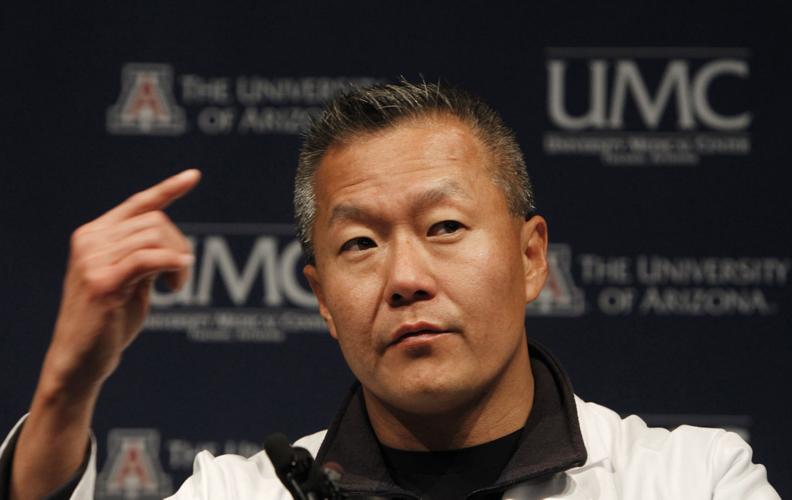Nationally known surgeon Dr. Peter Rhee has had 32 addresses in his life and the one where he's stayed the longest is in Tucson.
But that's about to change.
Rhee's last day as top trauma surgeon at Banner — University Medical Center Tucson is June 20, he confirmed this morning. His new job will be chief of acute care surgery and medical director of the Marcus Trauma Center at Grady Memorial Hospital in Atlanta.
"I love Tucson so much. Its greatest asset is its people. I am so sad I have to leave," Rhee said in a telephone interview. "I feel like I am abandoning the town I love and Tucson has been so good to me and the people have been so generous."
Grady is the fifth-largest public hospital in the country and serves a large number of low income patients.
"I've always considered my work public service," Rhee said. "They recruited me heavily for a long time now it is a county hospital working with inner city people as well as taking care of entire metropolitan Atlanta."
In Tucson, Rhee is a tenured surgery professor at the University of Arizona with an endowed $1.7 million chair and also chief of trauma, critical care, burn and emergency surgery at Banner — University Medical Center Tucson.
He first came to Tucson in 2007 to help revive the hospital's struggling trauma program. At that time, the hospital was locally owned and called University Medical Center. Rhee was recruited by Dr. Rainer Gruessner, who was then the new department of surgery chairman and left the hospital in 2013 in a bitter dispute with administration.
The hospital was taken over by Phoenix-based Banner Health in a merger that was completed in 2015.
Rhee sprung into action on the morning of Jan. 8, 2011 when the hospital’s trauma department was notified of a shooting on Tucson’s northwest side. The rampage was an assassination attempt on then-U.S. Rep. Gabrielle Giffords, and she was among the injured. She and 10 other victims were brought to UA Medical Center that day.
Gruessner recruited four of the six lead physicians who treated the Jan. 8 victims. Dr. Michael Lemole performed the surgery on Giffords and, along with Rhee, became a household name, with some media dubbing them “rock star surgeons.”
Rhee and Gruessner brought a research focus to the surgery department, with Rhee focusing, among other things, on gunshot wounds and on a last-ditch lifesaving method called suspended animation that involves bringing patients' bodies down to hypothermic temperatures by infusing a refrigerator-cold solution into their veins.
At Grady, Rhee will be going back into more academia and research, he says, working with two medical schools — Emory University School of Medicine and the Morehouse School of Medicine.
A 1983 graduate of Georgia Tech, Rhee earned his medical degree from Uniformed Services University of the Health Sciences, Bethesda, Maryland.
He has a masters in public health from the University of Washington is double boarded in general surgery and surgical critical care.
"We are extremely excited to have a surgeon of Dr. Rhee's extraordinary talents and experience join the Grady medical leadership team," Dr. Robert Jansen, executive vice president, chief medical officer and chief of staff at Grady Health System said in a prepared statement.
"Under his direction, Grady's already outstanding trauma services will advance to an even higher level of care."
Rhee serves on national steering and research committees, including the U.S. Food and Drug Administration's blood products advisory committee.
Grady Health System is one of the largest safety net health systems in the United States. Grady consists of the 953-bed Grady Memorial Hospital, six neighborhood health centers, Crestview Health & Rehabilitation Center, and Children's Healthcare of Atlanta at Hughes Spalding, which is operated as a Children's affiliate.
A South Korea-born surgeon, Rhee came to Southern Arizona from the Los Angeles County and the University of Southern California Navy Trauma Training Center, where he prepared U.S. Navy doctors and medical personnel for the battlefield. He saw the Tucson job as a challenge.
“The program was in disarray, the funding was a major issue and almost all the staff had left — which to me looked like an opportunity,” Rhee recalled in his 2014 memoir, “Trauma Red: The Making of a Surgeon in War and in America’s Cities.”
In that book, Rhee wrote that building up the local trauma program wasn’t easy. The only top-level trauma center in Southern Arizona, the Banner-University Medical Center Tucson handles about 5,000 patients per year whose injuries range from gunshot wounds and stabbings to car crashes and drownings. It wasn’t unusual for him to work 120-hour weeks, he wrote.
Rhee also wrote about all the gunshot wounds he's seen on the job, including the victims of the Jan. 8 shooting.
“The (Jan. 8) shooter had had a history of bizarre and disruptive behavior, the sort of guy that everyone knew had a mental problem, but in our free society there was nothing anybody could do about it. He had bought a gun at a Sportsman’s Warehouse, all very legally, and a month later he turned it on a crowd of innocent people. It was the same old story. Another nut with a gun in America.”





